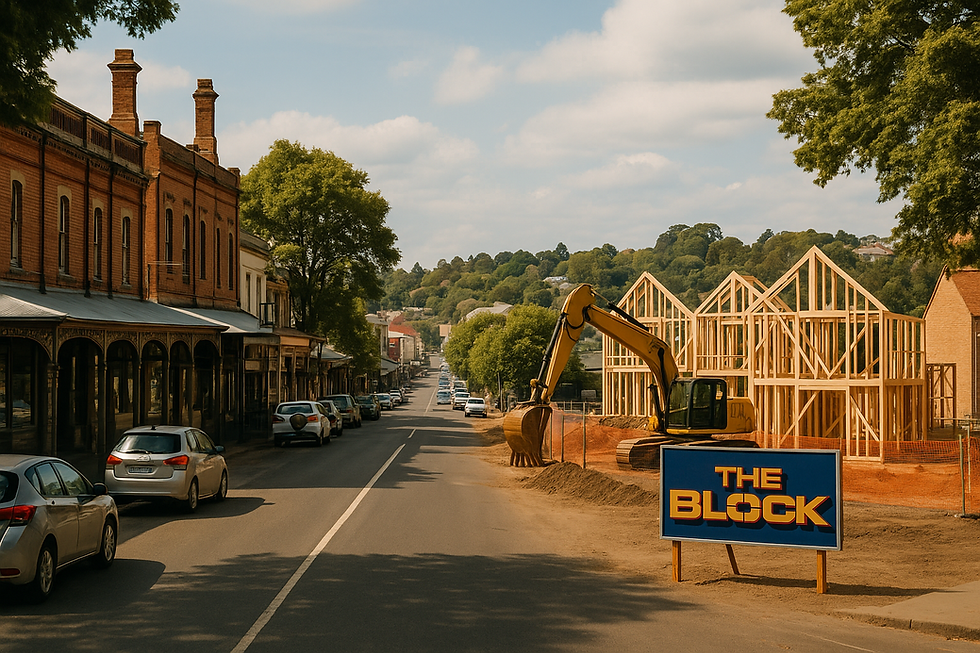Government’s Fast-Tracked Home Guarantee Scheme Sparks Heated Debate
- Dominique Oates
- Aug 31
- 4 min read
Updated: Sep 14

The Australian property market has once again taken centre stage this week, with the Federal Government’s announcement that its expanded Home Guarantee Scheme will launch earlier than planned—on 1 October 2025 instead of January 2026. The move, intended to help more first-home buyers enter the market with as little as a 5% deposit and no lenders’ mortgage insurance, has triggered a wave of commentary from economists, industry experts, and aspiring homeowners.
A Boost for First-Home Buyers
The government framed the early rollout as a measure to give Australians a “fairer shot” at owning their first home. Rising living costs and stubbornly high property prices have left many buyers locked out, with saving for a 20% deposit often taking close to a decade in major capitals.
Under the scheme, eligible buyers can secure a property with just a fraction of the typical deposit requirement, with the government guaranteeing the difference. Supporters argue that this could dramatically reduce barriers for young Australians, renters, and single parents struggling to get a foothold in the market.
“Pouring Gasoline on a Fire”
Not everyone is convinced. Former Reserve Bank economist Martin Eftimoski warned that the scheme’s timing could backfire, likening it to “pouring gasoline on a fire.” His concern: while the policy helps buyers with deposits, it does nothing to increase housing supply.
With national dwelling prices rising 0.6% in the past month alone, and 3.3% higher year-on-year, economists fear that injecting more demand into an already constrained market could push property prices even further out of reach.
The Affordability Tug-of-War
This tension—between boosting access and preventing further inflation—sits at the heart of the debate.
Supporters say: It’s a lifeline for first-home buyers who can afford mortgage repayments but can’t clear the deposit hurdle.
Critics warn: It risks inflating demand while supply pipelines remain clogged by planning delays, construction bottlenecks, and high building costs.
The debate highlights a fundamental challenge in housing policy: solving affordability requires both demand-side support (like the scheme) and supply-side reform (like zoning changes, land releases, and incentives for new builds).
Regional Impacts
The impact of the fast-tracked scheme is expected to vary across Australia, with distinct regional dynamics at play:
Sydney & Melbourne: Already Australia’s most expensive markets, these cities are expected to see heightened competition in the sub-$800,000 bracket where many first-home buyers are concentrated. Entry-level apartments and outer-ring houses may surge in demand.
Brisbane: With strong interstate migration and ongoing infrastructure projects tied to the 2032 Olympics, Brisbane could experience intensified competition, particularly in middle-ring suburbs where affordability remains better than Sydney and Melbourne.
Perth: Having recorded some of the strongest price growth nationally over the past 18 months, Perth is likely to see further demand pressure. Its relative affordability compared with eastern capitals may attract both local first-home buyers and interstate migrants.
Adelaide & Hobart: Limited supply pipelines and already-tight rental markets suggest these cities could be particularly sensitive to increased demand from the scheme. Price growth may accelerate further if stock shortages persist.
Regional Centres (Newcastle, Geelong, Sunshine Coast, Townsville): Regional cities with lifestyle appeal and strong infrastructure investment may see a surge in demand, especially as more first-home buyers are priced out of capital city markets. These areas could become the main beneficiaries of the scheme.
Political and Economic Stakes
Beyond economics, the scheme carries political weight. Housing affordability is a hot-button issue, and governments are under mounting pressure to demonstrate action. The early rollout offers immediate relief for some, but the broader market consequences could define housing policy narratives leading into future elections.
Industry analysts also note that investors are watching closely. While the scheme doesn’t directly apply to them, any demand-driven price growth could further strengthen investor appetite, particularly in high-growth suburbs and regional hubs.
Investment Insights
For investors, the scheme presents both opportunities and risks:
Entry-Level Properties: Assets priced under $800,000 are likely to see the strongest demand uplift. Investors holding stock in this range could benefit from accelerated capital growth.
Outer-Ring Suburbs & Growth Corridors: As first-home buyers target affordability, fringe suburbs around major capitals (Western Sydney, Melbourne’s north and west, Brisbane’s Logan/Ipswich corridor) could experience price pressure and rental demand increases.
Regional Lifestyle Hubs: Areas like the Sunshine Coast, Geelong, Newcastle, and Townsville may attract first-home buyers chasing affordability and lifestyle. Investors positioned early in these markets may benefit from capital appreciation.
Rental Market Pressures: As more renters transition into ownership, rental demand may ease slightly at the lower end. However, in supply-constrained regions, this shift is unlikely to create significant rental relief. Investors in these areas may still enjoy strong yields.
Risk of Overheating: Investors must remain cautious. If the scheme drives short-term demand spikes without addressing supply shortages, entry-level markets may overheat, creating risks of price corrections once stimulus fades.
Investor Strategy Tip: Target quality assets in affordable growth corridors—properties with strong fundamentals (land component, infrastructure links, lifestyle appeal) that can withstand both short-term demand surges and long-term structural growth.
Looking Ahead
With the scheme set to begin in just over a month, the property market is bracing for a surge in buyer activity. Real estate professionals anticipate increased competition at auctions and private sales from October onwards, particularly at the entry-level price point where first-home buyers are most active.
Whether the scheme delivers relief or fuels further price growth remains to be seen. What is clear is that the fast-tracked Home Guarantee Scheme has become the most talked-about issue in Australian property this week—and is likely to remain front of mind for buyers, sellers, investors, and policymakers alike in the months ahead.
✅ Key Takeaway:
The government’s decision to accelerate the Home Guarantee Scheme has ignited the national property conversation—balancing hope for first-home buyers against warnings of market overheating. For investors, affordable growth corridors and regional lifestyle hubs may offer the strongest opportunities, though caution is advised in markets prone to short-term overheating.
.png)



